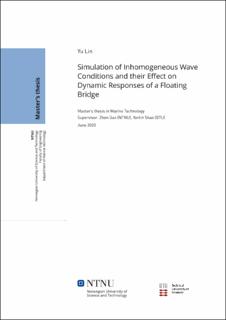| dc.description.abstract | The Norwegian Public Roads Administration (NPRA) has launched The Ferry-free E39 Coastal Highway Route project in order to reduce the travel time from 21 hours to 11 hours between Trondheim and Kristiansand by applying bridges and tunnels to replace the current fjord ferries. In this study, one of the seven fjords, Bjørnafjorden is focused. The end-anchored curved floating bridge which is a long curved structure of 5 km supported by 19 was proposed to cross Bjørnafjorden. Due to the complex topography of Bjørnafjorden, the wave field is inhomogeneous along the fjord which might excite asymmetrical eigenmodes of the floating bridge. The inhomogeneity of the wave field was revealed by analyzing the wave elevation data collected by three Datawell Waveriders (DWRs). Since it is hard to keep collecting real-time wave elevations for a long period, numerical simulation of the inhomogeneous short-term wave field is necessary to be carried out in this study.
The 3-hour short term simulation of times series at each pontoon requires known wave spectrum and coherence between wave elevations along the fjord. The coherence structure of the waves across the fjord is assumed based on the analysis of collected wave data. The coherence structure along the fjord plays an important role in each simulation since it exists among the wave field objectively and it is essential to compute cross-spectrum. By applying the proposed coherence functions at 19 pontoons, a Matlab code was developed to generate time series of the wave elevations with two methods, Campbell analogy, and Cholesky decomposition. The criterion for evaluating the quality of the wave elevation method is to assess if the wave characteristics such as significant wave height and wave peak period of generated wave elevations can return to the input data. In this paper, four cases are conducted which include 1-year, 100-year homogeneous wave condition, and 1-year, 100-year inhomogeneous wave condition. The inhomogeneity of the input data of four combinations is reflected in significant wave heights while the input data have the same wave directions 288 [deg] and homogeneous peak wave periods. The results, wave characteristics, of two methods, are always inhomogeneous due to the constitutional randomness inside the wave simulation procedure. By comparing the results of four cases, the Cholesky decomposition method has better performance than Campbell analogy in general and the simulations perform more accurately for 100-year wave condition with a lower deviation rate below 2 percent.
Furthermore, with the given numerical model of the floating bridge provided by Cheng in the software SIMA, the effects on the global dynamic responses of the floating bridge, including the bridge girder cross-sectional loads, moments of the bridge girder and the rigid body motions. In addition, wave excitation loads are generated by Matlab code on different pontoons considering the inhomogeneous wave condition and are imported as external forces into SIMA simulations. | |
